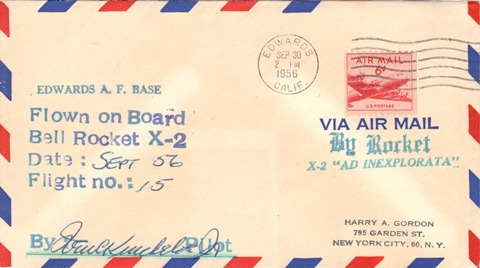Space Cover #385: The End of the X-2Above is a cover that was machine canceled at Edwards on September 30, 1956, three days after the tragic end to the X-2 program, and autographed by X-2 pilot Iven Kincheloe. We will discuss the cachet notation about the cover being flown onboard the X-2 in a few more paragraphs.
We discussed the beginnings of the X-2 and its first powered flight in Space Cover of the Week 345. And the covers carried on the spring, 1956 flights in Space Cover of the Week 365. The X-2 reached a speed record of Mach 2.87 on July 23, 1956 as described in Space Cover of the Week 122. So, now it's time to fill in the last two months of the X-2 program.
Following Air Force Major Pete Everest's July 23, 1956 speed record flight, the mantle passed to Captain Iven Kincheloe to probe the altitude limits of the X-2. He pushed the X-2 to 87,750 feet altitude, just shy of the record set by the X-1A, on August 3. Then he had engine problems on his next flight on August 8. Finally on September 7, 1956, Kincheloe set an altitude record of 126,200 feet (almost 24 miles).
Meanwhile, the NACA (NASA's predecessor) was anxious to get their hands on the oft-delayed X-2. They worked out an agreement where the Air Force would fly one more speed record attempt, then hand the rocketplane over to NACA for more in-depth research flights. The Air Force also wanted to have another qualified rocketplane pilot in their corps (Everest had transferred to another assignment), so they named Captain Milburn "Mel" Apt to pilot this mission. Apt had never flown the X-2 before.
Sixty years ago this week, on September 27, 1956, Apt flew the X-2 to a record speed of Mach 3.2. The rocket engines expended their last fuel at this point, and Apt turned back toward Edwards, sending the X-2 out of control and into a violent tumble. Apt ejected, but was knocked unconscious making him unable to open his main parachute, and was killed on impact. Both Apt and the X-2 program died that day.
Now, back to the cover above. There are a number of these around, all postmarked Sept. 30, and each is notated by Kincheloe as having flown on a different mission of the X-2 (the one above is noted as having flown on "Flight no: 15"). There is not a single cohesive flight numbering convention for the X-2. Kincheloe's three flights described above are listed as Flight nos. 9, 10, and 11 in NASA literature (although there were four early glide flights prior to what they called Flight 1). And Kincheloe's flights were acknowledged as the 10th, 11th, and 12th powered flights (the first powered flight was unsuccessful and counted as a glide flight).
So, this cover annotated as having flown on Flight 15 may have been flown on Kinch's September 7, 1956 flight (listed as Flight 11 in the NASA records, plus four glide flights to get 15), but likely not. And even this does not explain Kincheloe numbering covers for flights that he did not fly (I've seen one of these covers that Kincheloe annotated as having flown on Flight 7, long before he started flying the X-2). Clear as mud? I agree!
I'd theorize that Kincheloe had a stack of covers from Harry Gordon (the addressee on the cover above) that may have been flown on an X-2 flight, or may have simply been sitting in Kincheloe's desk. Three days after Apt's accident, Kincheloe may have just annotated each cover with a different flight number, signed each, and put them in the mail.
So, I can't come up with any logic that persuades me that the September 30, 1956 postmarked covers were actually flown on the X-2. Interestingly, the authors of the Ellington-Zwisler Rocket Mail Catalog did not list these covers as flown either, possibly due to the same or similar rationale.
However, this cover was likely at Edwards the day that Apt and the X-2 program met their end, carries an Iven Kincheloe autograph (very hard to find), and I'm happy with that piece of history, flown or not.












